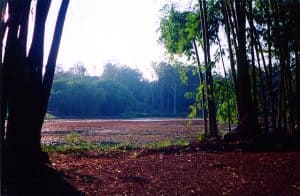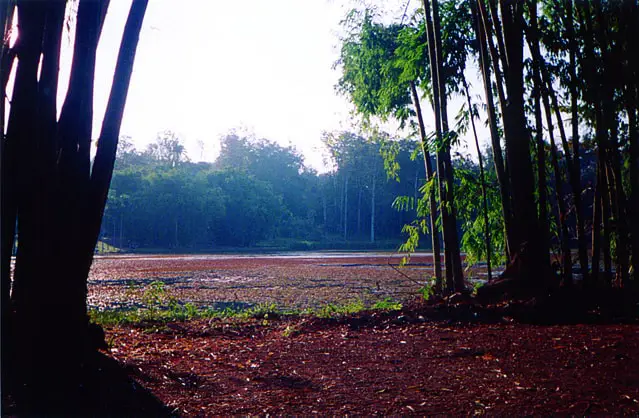
While most people who are lost for a short amount of time in the wild should just stop and wait for rescue, that’s not always a viable solution to your current situation. Having to take control and rescue yourself by moving until you find civilization can be intimidating and challenging.
Add in the fact that science has shown that people tend to wander in circles when lost or in the wild and this becomes an even bigger potential problem. Imagine walking two or three days, spending all that energy, and only ending up back where you started in the very beginning.
Just because people naturally tend to walk in circles when lost doesn’t mean this can’t be avoided. By focusing on a clear landmark in the distance or understanding the sun/moon strategy you can rescue yourself by walking in a straight line and avoiding walking around in circles. These strategies can keep you on course even without a compass or GPS.
Many people assume this would never happen to them if they were lost or found themselves in a wilderness survival situation, but many real life instances and several scientific studies suggest otherwise. So why do humans walk in circles? How can you walk in a straight line in the woods to help rescue yourself?
Read on to find out!
Table of Contents
How to Avoid Going in Circles in the Wild
There are a few major strategies that can help you make sure you keep heading in one direction when lost or in the wild. By understanding that this is a natural weakness in people that can have terrible repercussions if you’re trying to get “un-lost” or rescue yourself from an isolated wilderness challenge.
This article assumes that the many stories about people walking in circles caught your attention like they caught mine – especially when it was revealed that this isn’t just a desert or salt flat type of thing but also in thick forests. But forests have landmarks, don’t they?
Apparently in many survival situations, not enough, or not the right type. This made me pay a lot of attention and start looking for answers from professionals on how to avoid going in circles.
Most of these strategies are going to fall into one of two categories: being prepared with the right tools and non-tool survival strategies for being able to walk straight to rescue yourself.
Use Smart Tools to Walk Straight
The best way to avoid the wandering circle of death is to be prepared for any hiking, camping, or survival situation by having the right tools on hand. GPS is a pretty amazing technology, and it’s not just for vehicles anymore. However, it’s important to understand a few things before assuming you’re good to go with your current GPS choice.
Portable GPS Systems
This does not refer to anything connected to Wi-Fi or an app on your smartphone. We’re talking battery-powered portable GPS units for hunters, hikers, and deep wilderness activities that have a satellite link to plot out where you are and help point you in the right direction. These need to be designed to go many hours or days on pure battery power, work in the most rugged of conditions
Garmin is a company that provides many of the top models, but there are a couple others out there, as well. You’re looking for the type of GPS that is used by hunters, by trail builders, and by outdoor individuals who need a reliable and long lasting GPS. In other words, cell phones and cheap GPS models don’t count.
Compass (and map)
Even with those, you need a backup plan. While a compass and map combination may seem quaint compared to modern GPS tools, they also don’t run on batteries or die after getting dropped on the ground. While ideally you will have a compass and a map (topographical is even better if you know how to read it) just having a compass allows you to point in a very specific direction and to stay moving in that direction.
That is what’s important if you need to walk your way to a place for rescue or to get “un-lost.”
Our Top-Rated Portable GPS on Amazon.com
Our Top-Rated Compass on Amazon.com
Non-Tool Ways to Walk Straight in the Woods
While in an ideal situation you have one or two tools so you don’t have to rely on a base strategy for walking in a straight line and avoiding walking in circles when lost, you may find yourself in a situation where you are in extremely thick woods or a desert type setting and you don’t have any tools.
In this case there are a few major strategies you can use to help you stay on the quite literal straight and narrow.
The best option is to look for landmarks. Is there a clear landmark in the distance that you can see from about anywhere and which allows you to keep going in one direction. That is what you want to use. While the ideal situation is to head towards it, if you have a map saying that leads you further into the wilderness, you can even walk away from it, constantly checking your back to make sure you are lined up with that landmark. When you’re shifting to the left or right of it from your POV, you know it’s time to correct.
The sun and moon method is a popular off-shoot of this strategy. The focus with this is using the actual sun or moon as a landmark and heading towards it. While these move in the sky over time, the fact they are easy to spot allows one to move in the direction for a long period of time, and then adjust their movement as needed and use it to their side or back to still focus on going in the original direction. These act as a landmark that might be missing from a thick forest or a featureless desert.
The key is having that specific spot to hone in on. By being able to focus on that your mind keeps correcting itself to make sure you’re going straight as opposed to wandering off track and in circles.
If you want to avoid wandering in circles those are the best methods. If even those aren’t viable for some reason, there is one other method that can work but this should be last choice because it is less effective than the others, and it uses up energy which is at a premium when you find yourself in a survival situation.
Here you’re creating your own nearby landmark. Take a stick, a rock, something, and throw it straight ahead of you. Focus on that and walk forward. If it’s gone a few feet to either side, adjust (that way if you keep throwing off to the right or off to the left you don’t inadvertently pull yourself into a circle), throw again, and follow again.
This isn’t the best strategy because you’re burning extra energy and if you’re not careful and not correcting, you can still start slanting one direction or another which can eventually turn you around back into a circle.
Perception adjusts constantly
The first step to overcoming the natural handicaps that make it hard to walk in a straight line in the woods is first understanding that this actually is a challenge. Human perception adjusts constantly. When you don’t have anything to focus on in the distance, distinctive changing scenery that indicates direction or how far you’ve gone, the senses get confused and the random circular wandering in the wild begins.
Understanding that, and taking steps to overcome it, give you a much better chance of getting to safety if you find yourself lost or needing to self-rescue.
Walking in Circles Studies
Honestly when I first heard about this, I was really surprised. There were a few times in my life where I found myself in wilderness survival situations or potential emergency situations in the wild that required me to save myself. Using tools I had on me, falling back on some preparation that became second habit before taking any trip, and committing to a landmark in the distance helped me focus on one direction and keep going.
This has long been a wives’ tale or bit of outdoor expert knowledge, but actual studies were done that confirmed these habits and came up with some interesting results.
Jan Souman did a study in the Sahara Desert in 2007 and is the first actual scientific study (i.e. using the scientific method) that proved the wandering in circles, or at least the inability to walk in a straight line, was actually true. The volunteers were told to travel in a straight line, were monitored, and the same study was repeated with people in an open field who were blind folded.
How quickly volunteers started veering or going in circles (and not perfect spirals but random erratic direction changing circles) was startling and confirmed the stories. The walking in circles study went on to have volunteers walk through the woods in both day and night. Turned out that the cloudier the day, the more quickly and thoroughly people walked in circles.
Without that reference point to keep the vision focused, people would just start wandering and not even realize it.
Several years later researchers at the Max Planck Institute in Germany did a study on walking in circles or “looping walks” and tried to figure out what the root cause was. While the current popular theory relates to patterns in the brain, common theories that have been used in the past have been disproved included one leg being slightly longer than the other and right-hand/left-hand dominance.
These studies even caught the attention of ABC News & NBC News.
In Conclusion
While there have only been a few studies on walking in circles when lost or in the wild, the early data has still given us plenty of information. This isn’t just a story – it’s an important concern. In most survival situations you want to find a good place to get food, water, signal for help, and be found, but sometimes that isn’t a viable option – especially if no one knows you’re lost or stranded.
By understanding how to walk in a straight line in the woods or desert when lost, or any other terrain for that matter, you give yourself a much better chance of making it out alive!

